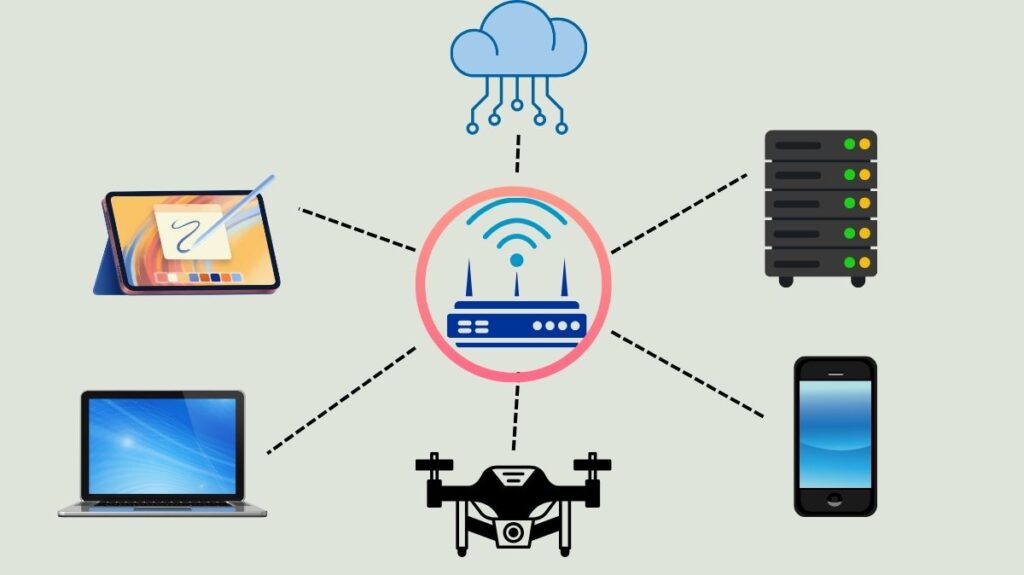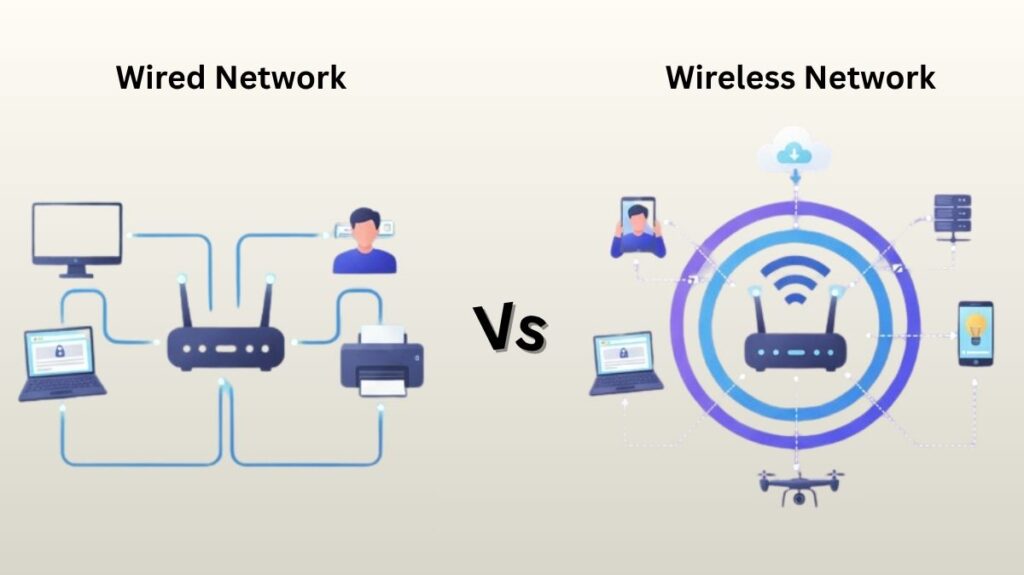Wireless networks, wireless terminologies and topologies, wireless vs wired network, radio frequencies and IEEE 802.11 standards, wireless network security, and challenges were all covered in this blog.
Wireless networks

Computer networks that use radio waves or infrared/light signals rather than physical wires to transfer data between devices are known as wireless networks. Users can travel freely within the network coverage area while staying connected because to this reliance on radio frequency (RF) connections, which also offers mobility and flexibility.
The Wi-Fi Alliance, an organisation that promotes interoperability and development, is in charge of overseeing the widely used trademarked word for wireless local-area networks (WLANs), Wi-Fi. The IEEE 802.11 set of specifications serves as the foundation for the basic definition and functionality of Wi-Fi.
Also Read About Wireless Local Area Network WLAN Creation and Components
Wireless Terminology and Topologies
Several essential structural components are defined by the 802.11 standard:
- Basic Service Set (BSS): The core service area that connects all related wireless clients and is offered by a single access point. The Basic Service Area (BSA) is the geographical region that is covered.
- The AP that provides the BSS is identified by its unique, machine-readable MAC address, which is known as the Basic Service Set Identifier (BSSID).
- When two or more BSSs are linked by a single wired Distribution System (DS), an Extended Service Set (ESS) is created that enables wireless clients to move freely between APs.
- The AP advertises its service using the Service Set Identifier (SSID), a human-readable, non-unique identifier with a maximum length of 32 characters.
- Ad Hoc Mode, also known as Independent Basic Service Set (IBSS), enables direct communication between two or more wireless clients (peers) without the need for an AP. Ad hoc networks are typically seen as being somewhat unsafe and unscalable.
- When it is not feasible to install Ethernet cabling to every AP, mesh networks are utilized. Wireless backhaul links are used by mesh APs to transmit client traffic to one another.
- The most popular connection type is called “Infrastructure Mode,” in which an AP serves as the hub for all client connections.
Also Read About What Is IEEE 802.1Q? The Key To VLANs In Ethernet Networks
Different types of wireless networks
Geographical size and range are used to categorise wireless networks:
| Type | Full Name | Range | Common Technology/Example |
|---|---|---|---|
| WPAN | Wireless Personal Area Network | (less than 5–10 meters or ≈30 feet) | Bluetooth, Zigbee |
| WLAN | Wireless Local Area Network | Limited area (home, office, campus, typically less than 100 meters) | Wi-Fi (IEEE 802.11) |
| WMAN | Wireless Metro Area Network | Large geographic area like a city or suburb (over 100 meters) | WiMAX (IEEE 802.16) |
| WWAN | Wireless Wide Area Network | Vast geographical distances (state, country) | Cellular technology (4G/5G, LTE) |
Wireless vs Wired Network

Wireless networks differ from wired networks, which are typically full duplex and frequently employ Ethernet LANs based on IEEE 802.3.
- Transmission Medium: RF signals are used by wireless networks to communicate over the air.
- Duplex Mode: Half-duplex mode is usually used by wireless LAN devices. This implies that only one device can transmit or receive at a time because the medium (the radio frequency) is a common resource that all stations must compete for.
- Collision Management: Wireless networks employ the CSMA/CA (Carrier Sense Multi Access / Collision Avoidance) protocol to control access and avoid collisions because it is challenging to detect collisions over radio waves.
Key Components
A wireless Access Point (AP) and a wireless Network Interface Card (NIC) are the two main components required to set up a basic wireless network:
- Similar to a hub or switch in a wired network, an access point (AP) serves as a central junction point. The AP serves as a link between the wired network and wireless client devices. To inform clients that the network is available, APs broadcast a beacon, which is a notification that contains the network’s name (SSID).
- Client devices (laptops, phones, etc.) use wireless network interface cards (NICs) to transform digital data into radio signals that can be transmitted.
- In medium-to-large networks, the Wireless LAN Controller (WLC) is used to centrally manage and control access points. For configuration, lightweight APs (LAPs) depend on a WLC. The CAPWAP tunnelling protocol is used for communication between LAPs and the WLC. A split-MAC architecture is the name given to this configuration.
- Wireless Broadband Router (SOHO): An Ethernet switch, firewall, router, and access point are frequently combined into a single consumer device in small office/home office settings.
Radio Frequencies and IEEE 802.11 Standards
Signal transmission across unlicensed radio frequencies (RF) is the foundation of wireless networks. The 2.4 GHz and 5 GHz bands are the main ones used by IEEE 802.11 standards. These belong to the free Industrial, Scientific, and Medical (ISM) band, which is susceptible to interference due to its widespread use.
Frequency Details
- Only channels 1, 6, and 11 are far enough away to be regarded as non-overlapping in the 2.4 GHz band, where channels are usually too widely separated to prevent overlap.
- Channels in the 5 GHz range are typically thought of as non-overlapping. Higher data rates are usually supported by higher frequencies.
Also Read About Cisco WLC GUI Security Settings And Advanced WLAN Settings
Important Wi-Fi Standards
More speed (data rate) is offered by newer standards, which frequently make use of certain technologies:
| IEEE Standard | Frequency Band | Maximum Data Rate | Key Technology/Notes |
|---|---|---|---|
| 802.11b | 2.4 GHz | 11 Mbps | Widely adopted |
| 802.11a | 5 GHz | 54 Mbps | Uses OFDM |
| 802.11g | 2.4 GHz | 54 Mbps | Backward compatible with 802.11b, uses OFDM |
| 802.11n (Wi-Fi 4) | 2.4 GHz and 5 GHz | Up to 600 Mbps | Utilizes MIMO (Multiple Input, Multiple Output) |
| 802.11ac (Wi-Fi 5) | 5 GHz | Up to 6.93 Gbps or 3.5 Gbps | Very high throughput (VHT) |
| 802.11ax (Wi-Fi 6) | 2.4 GHz and 5 GHz (+ 6 GHz for Wi-Fi 6E) | Up to 9.6 Gbps | High Efficiency Wireless, leverages OFDMA |
Security in wireless networks
Strong security with an emphasis on encryption and authentication is necessary since wireless connections send data over public spaces.
- The original 802.11 security method, known as Wired Equivalent Privacy (WEP), makes use of static WEP keys and the RC4 stream cypher. WEP has cryptographic vulnerabilities that make it susceptible and deprecated.
- The Wi-Fi Alliance created Wi-Fi Protected Access (WPA) to solve WEP problems. The Temporal Key Integrity Protocol (TKIP), which makes use of dynamic per-frame encryption keys, was first presented by WPA.
- WPA2: The complete IEEE 802.11i standard serves as its foundation. For encryption and integrity, it makes use of AES-CCMP (Advanced Encryption Standard – Counter Mode with Cypher Block Chaining Message Authentication Code Protocol).
WPA2 has two modes: Enterprise mode, which requires an external RADIUS authentication server and 802.1x/EAP, and Personal mode (PSK), which employs a pre-shared key.
- The most recent standard, WPA3, was unveiled in 2018. It uses the Galois/Counter Mode Protocol, or GCMP. SAE (Simultaneous Authentication of Equals), sometimes referred to as the Dragonfly handshake, is used in WPA3 Personal mode to prevent dictionary attacks.
Challenges
Wireless networks suffer a number of difficulties despite their benefits, which include mobility and ease of installation:
- Interference: Signal quality may be weakened by excessive use of unlicensed 2.4 GHz and 5 GHz bands.
- Coverage: Materials have an impact on the strength and quality of signals (for example, metal reflects, water and the human body absorb).
- Security: Because data “flies around in the air” in wireless networks, they may be less secure than wired networks if improperly setup.
- Reflection (bouncing off objects), scattering (splitting into several weaker pieces), and absorption (material absorbing the signal) are three ways that wireless transmissions might degrade.
Also Read About Wi Fi Protected Access 2 WPA2 Definition and How WPA2 Works
